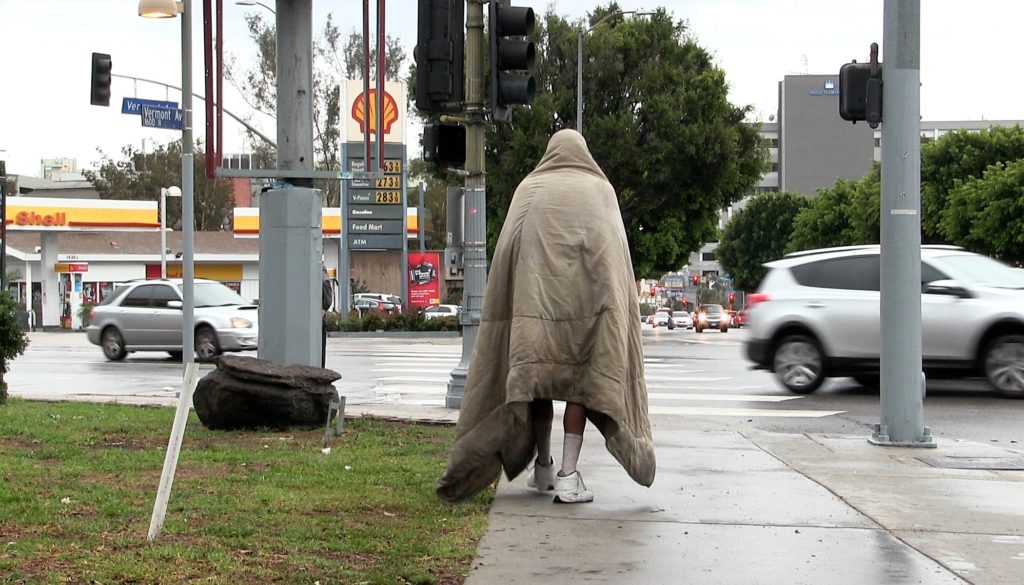Southern California was battered with a cold, rainy and snowy weather system that moved in February 24. The National Weather Service called the storm “one of the strongest ever to hit the region.”
In the first 24 hours, the rain gauge on Radcliffe recorded 4.5 inches of rain. Another .6 inches of rain was added through February 26, which brought the storm total to 5.1 inches of rain.
Normal annual rainfall for Pacific Palisades, measured from July 1 through June 30 is 13.78 inches of rain. Currently, the area has recorded 21.1 inches of rain, with more predicted over the next few days.
The total rainfall in 2020-21 was 4.26 inches of rain. And 2006-2007 had 4.11 inches of rain, the driest in Palisades history since record keeping started in 1942.
Around noon on February 25, sleet and tiny piece of hail pelted Pacific Palisades. At about the same time, all L.A. County beaches were closed due to lightning strikes.
The high temperature on Saturday was 48 degrees and overnight, temperatures dropped to 38 degrees.
Electrical and internet outages were reported in town.
A large tree on Baylor Street, near the Las Casas intersection toppled, hitting a power pole, leaving some people south of Sunset without power.
There were reports of trees downed by the Via de la Olas bluffs and along Temescal Canyon Road.
Many residents in the Huntington Palisades have been without electricity since Friday. One wrote in a social media post wrote “After two hours on hold I got through to a rep at LADWP. This is a level 3 response, their highest level, and they don’t provide estimates any longer. He said he would prepare for 3-4 days given the severity of the storm. He specifically mentioned that underground vaults have been flooded and are particularly dangerous to repair and take time.
Another resident wrote to CTN that “the traffic light has been out at Chautauqua and Sunset for two days, now. The drivers are rude and don’t treat it as a four-way stop. Standing and watching for five minutes, you wouldn’t believe how many people almost got into an accident. It’s very dangerous.”
Around 4:30 p.m. on Sunday, February 26, the reader sent a photo (below) and said “DWP crews are now working at Sunset and Chautauqua.”
Los Angeles Department of Water and Power (LADWP) put out a statement on February 26. “Over the past 24 hours, crews have restored power to 50,000 customers. Overall, since the start of the storm Friday, crews have restored power to more than 98,000 customers. There are currently 49,000 customers out of LADWP’s 1.5 million electric customers who are still without power.” Residents can sign up for outage alerts, visit: ladwp.com/OutageAlert.
WEATHER RELATED:
Snow fell in portions of the San Bernadino Mountains and other areas inland that rarely see it. The section of Interstate 5 known as Grapevine, has been closed several times over the past few days. That road goes through the Fort Tejon Pass between the southwest end of the Tehachapi Mountains and northeastern San Emigdio Mountains, and links Southern California to the Central Valley.
The Los Angeles Fire Department reported on February 25, at 12:46 a.m. of a Sepulveda Basin Helicopter Rescue.
“During a night of extreme winter weather with cold, heavy, wind-driven rain, LAFD ground and air responders came to the aid of four homeless adults, three males and one female, as well as four dogs and one cat who were stranded in a remote area of land within the heavily flooded Sepulveda Flood Control Basin.
“An LAFD Helicopter landed to safely rescue the four adults and five pet animals, transferring them all directly to the LAFD Air Operations facility at Van Nuys Airport, where they were medically evaluated by LAFD Paramedics. Two of the adults were determined to be suffering from hypothermia and were transported to an area hospital. The two remaining adults declined offered ambulance transportation, and took possession of the five animals, which appeared uninjured. No further details.”
HOMELESS WINTER SHELTERS RARE:
CTN reported in 2022 on homeless winter shelters click here.
Annually, the Los Angeles Homeless Services Authority (LAHSA) operates a winter shelter program that generally runs from December 1 through March. These emergency shelters provide a warm place to sleep, food and assistance. Although L.A. County has an estimated 66,000-plus homeless, there are only 315 shelter beds at 11 locations and zero shelters on the Westside.
“This is totally unacceptable during the cold rainy winter months,” said Pacific Palisades Task Force on Homelessness co-president Sharon Kilbride. “These poor folks had to make do on the streets during the storm.”
She noted that there is “so much money is thrown at homelessness and no winter shelters.”
This year LAHSA has decreased the number of shelter beds from 315 to 270.
According to a February 23, 2023 L.A. Times story (“Southern California Races to Shelter Homeless People as Frigid Storm Bears Down”), “Besides about 11,000 year-round shelter beds, LAHSA opens an additional 270 seasonal beds from November through March.
“Last year, the agency cut back its winter program from 11 to five shelter in a shift to a voucher program that allows outreach workers to place people in motel rooms.
“There are 27 hotels enrolled in that program, officials said. The program was budgeted for 142 beds in the city of Los Angeles and 367 in the remainder of the county. Outreach workers have been supplementing those with vouchers from other programs.”
Molly Rysman, chief programs officer with the Los Angeles Homeless Services Authority, blamed the lack of winter housing for the homeless on climate change. She also said the Westside is a problem for the agency because of the high need, but has had difficulty in opening interim housing.
“We have not figured out how to secure the resources to address all the extreme weather conditions that are now part of our regular work, and it’s really year-round,” Rysman told the Times.




